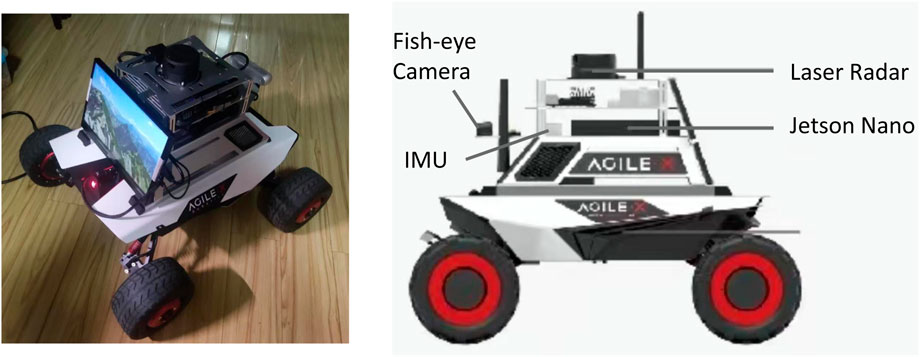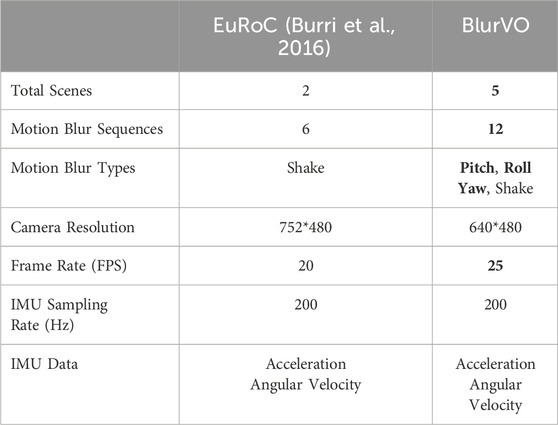- 1Ecology and Innovation Center of Intelligent Driving (BeeLab), Soochow University, Suzhou, China
- 2Harbin Institute of Technology, Harbin, China
- 3Horizon Robotics, Beijing, China
Introduction: Motion blur, primarily caused by rapid camera movements, significantly challenges the robustness of feature point tracking in visual odometry (VO).
Methods: This paper introduces a robust and efficient approach for motion blur detection and recovery in blur-prone environments (e.g., with rapid movements and uneven terrains). Notably, the Inertial Measurement Unit (IMU) is utilized for motion blur detection, followed by a blur selection and restoration strategy within the motion frame sequence. It marks a substantial improvement over traditional visual methods (typically slow and less effective, falling short in meeting VO’s realtime performance demands). To address the scarcity of datasets catering to the image blurring challenge in VO, we also present the BlurVO dataset. This publicly available dataset is richly annotated and encompasses diverse blurred scenes, providing an ideal environment for motion blur evaluation.
1 Introduction
Visual Odometry (VO) is pivotal in visual synchronized localization and mapping (V-SLAM), robotic autonomous navigation, virtual/augmented/mixed reality, etc. (Nistér et al., 2004). However, motion blur, often occurring in dynamic environments such as when a wheeled robot traverses bumpy roads, poses significant challenges to VO by impairing the accuracy of feature point matching between frames, as presented in Figure 1. The primary challenge in VO under such conditions is the reduction of tracking failures due to motion blur. Moreover, there is a notable scarcity of public datasets explicitly representing motion blur scenarios in VO.
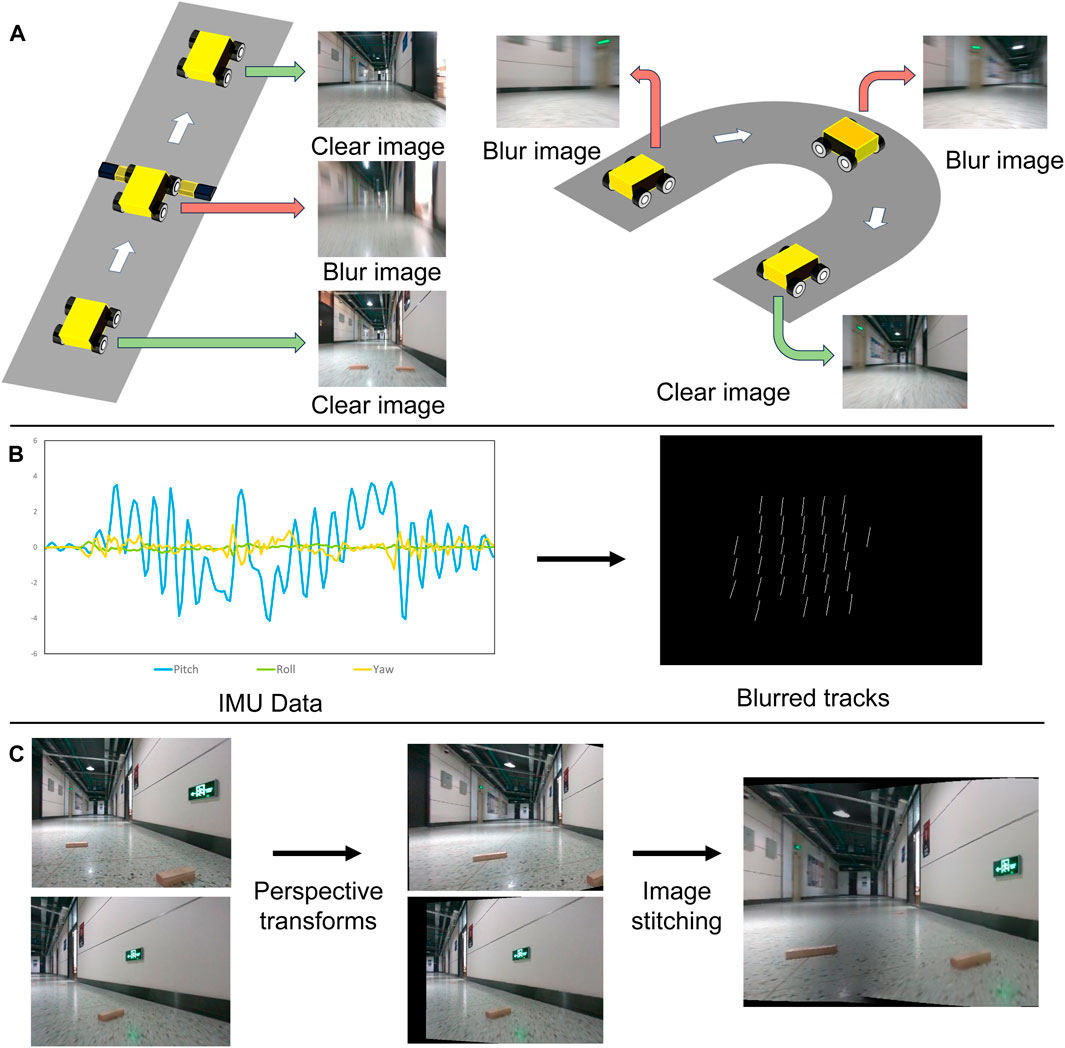
Figure 1. Illustration of blur occurring, detecting, and restoring: (A) Motion blur often occurs on obstacles and cornering. (B) The blur trajectories are derived from the IMU data, and the fuzzy images are screened according to the trajectory length. (C) The image perspective is transformed to the same viewing angle and stitched for blurry restoration.
To enhance VO robustness, we introduce an efficient approach for filtering and restoring blurred frames in blur-prone environments, such as rapid movements and uneven terrains. Particularly, to assess motion blur in images, our approach leverages IMU (Inertial Measurement Unit) data to provide a direct and efficient means of blur estimation. To further restore the blurry sequence, an empirical debluring strategy is proposed based on adjacent frame filtering and fusion. It should be noted that involving IMU in VO is not unprecedented. For instance, VI-DSO (Von Stumberg et al., 2018) and ORB-SLAM3 Monocular Inertial (Campos et al., 2021) use IMU data for pose estimation. However, these methods fall short of reducing tracking failures in severe motion blur scenarios. Our approach, in contrast, effectively utilizes IMU data to detect and restore motion blur (aka. blurry sequences), thus improving the initialization speed and overall robustness of VO. Notably, our method is compatible with various IMU sensors, enhancing its applicability. For the lack of dataset challenge, we introduce a new publicly available dataset, BlurVO, for indoor and outdoor motion blur evaluations in VO. Comprising 12 sequences from various real-world environments, BlurVO is equipped with data from pre-calibrated cameras and IMUs, fostering the development of more robust algorithms for VO in blur-prone scenarios.
Our main contributions are as follows: (1) We introduce a simple yet efficient approach for motion blur detection and restoration based on IMU. It marks a substantial improvement over traditional visual methods in terms of real-time performance, high-accurate blur estimation and recovery, and robustness of VO in challenging environments. (2) We introduce a new dataset, BlurVO, which contains a rich collection of blurry clips (both frames and corresponding IMU data) from various environments to promote further research tasks toward the robustness of VO.
2 Related work
We concisely survey existing VO and blur-related methods, including blur detection and datasets. For more detailed treatments of these topics, the compilation by He (He et al., 2020), and Vankawala (Vankawala et al., 2015) offer a sufficiently good review.
2.1 Visual odometry
Visual odometry methods can be broadly categorized into classical geometric, deep learning-based, and hybrid methods. Classical geometric methods: such as those by Davison (Davison, 2003) and Nister et al. (Nistér et al., 2004), and popular implementations like ORB-SLAM3 (Campos et al., 2021), rely on feature extraction and matching. Direct methods, including LSD-SLAM (Engel et al., 2014) and DSO (Von Stumberg et al., 2018), optimize camera pose based on photometric consistency. However, these methods often presuppose smooth camera motion and struggle with motion blur. Deep learning-based methods: initiated by Roberts (Roberts et al., 2008), aim for end-to-end pose estimation but face challenges in real-time processing. Hybrid methods: combining classical and deep learning approaches, seek to improve robustness but still grapple with motion blur. Our work diverges by leveraging sharp frames, employing a deblurring network selectively, and enhancing VO robustness in blur-prone environments. Note that VIO (Visual Inertial Odometry) combines image and IMU data, with notable examples like OKVIS (Leutenegger et al., 2013) and VINS-Mono (Qin et al., 2018). These methods achieve high accuracy but often require high-precision IMUs and do not specifically address motion blur. Our approach uniquely utilizes IMU data for detecting and recovering from motion blur, thereby enhancing VO performance with a broader range of IMU sensors.
2.2 Blur detection and restoration
Motion blur usually degrades the edges of objects in an image. Traditional methods for detecting blur usually extract features such as gradient and frequency to describe the changes in edges (Chen et al., 2013). Yi and Eramian (Yi and Eramian, 2016) designed a sharpness metric based on local binary patterns and used it to separate an image’s in-focus and out-of-focus areas. Tang et al. (Tang et al., 2017) designed a logarithmic mean spectral residual metric to obtain a rough blur map. Then, they proposed an iterative update mechanism to refine the blur map from coarse to fine based on the intrinsic correlation of similar adjacent image regions. Although traditional methods have achieved great success in blur detection, they are only effective for images with simple structures and are not robust enough for complex scenes. Due to their high-level feature extraction and learning capabilities, deep CNN-based methods have refreshed the records of many computer vision tasks. Purohit et al. (Purohit et al., 2018) proposed to train two sub-networks to learn global context and local features, respectively, and then aggregate the pixel-level probabilities estimated by the two networks and feed them into the MRF-based blur region segmentation framework. Zhao et al. (Zhao et al., 2023) proposed a heterogeneous distillation mechanism to generate blur response maps by combining local feature representation and global content perception. However, these methods are highly complex and challenging to process in real-time. Our method uses IMU data as prior information to calculate the length of each image blur kernel. It uses these lengths to judge whether the image is blurry. This method balances efficiency, robustness, and applicability.
Recent CNN-based deblurring networks (e.g., Kupyn (Kupyn et al., 2019) and Cho (Cho et al., 2021)) focus only on single-frame restoration and have difficulty achieving real-time performance for motion blur over frame sequences. Thanks to the prior information (frame category) from the IMU, our proposed strategy can select appropriate operations for repair (deletion, retention, and restoration) for different blurry frames.
2.3 SLAM dataset
In terms of blur-related datasets, as summarized in Table 1. Most existing SLAM datasets focus on autonomous driving (Geiger et al., 2013) (Wen et al., 2020) (Ligocki et al., 2020) or drones (Burri et al., 2016). Some datasets are targeted at ground robots. OpenLORIS (Shi et al., 2020) is collected in indoor environments by a wheeled robot designed for visual SLAM, where LiDAR SLAM is used to generate ground truth. In some cases, LiDAR SLAM can have larger errors than visual SLAM, making the ground truth unreliable. TUM RGBD (Sturm et al., 2012) partially uses robots as an acquisition platform but only contains RGB and depth cameras. Similar datasets include UTIAS MultiRobot (Leung et al., 2011), PanoraMIS (Benseddik et al., 2020), and M2DGR (Yin et al., 2021). Unfortunately, the above datasets do not specifically record scenes of violent robot movements. Even if some have relevant scenes, the number is minimal and insufficient to support dedicated motion blur research. Our BlurVO dataset is designed for comprehensive motion blur evaluation, covering different types and scenes of motion blur, filling a major gap in current research.
3 Our method
This part aims to detect and restore the motion blur sequence that affects VO robustness and V-SLAM operation. As presented in Figure 2, our method comprises two primary components: Motion Blur Detection and Motion Blur Recovery, aiming to detect and correct blurred frames in VO through IMU data analysis.
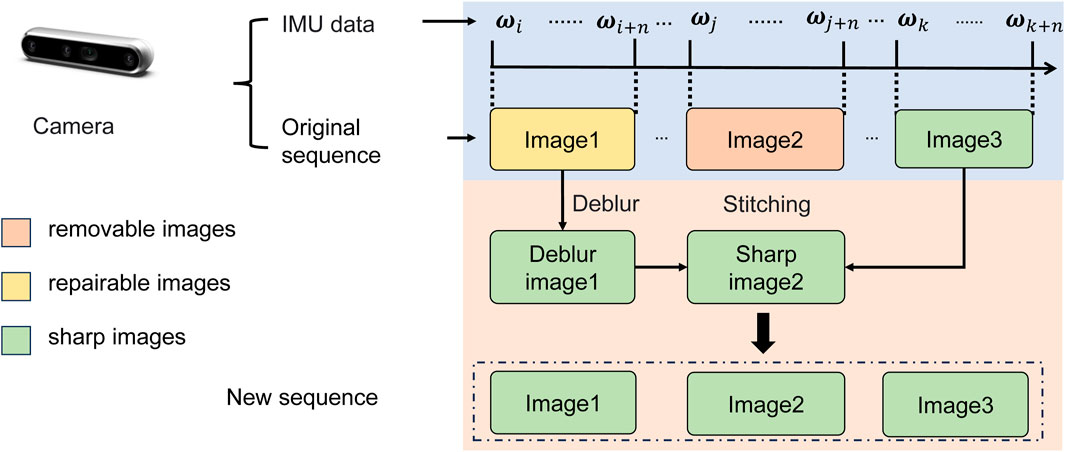
Figure 2. Our method consists of two main parts: Motion Blur Detection (top) and Motion Blur Recovery (down).
3.1 Motion blur detection
3.1.1 Blurry Categories
As detailed in Figure 2, we assess the blurry degree of each frame based on the IMU data corresponding to the image sequences. Built on that, the frames are divided into three categories: (1) Removable: Over-blurred frames, will be dropped directly. (2) Sharp: Qualified frames, will be kept without any changes. (3) Repairable: Slight-blurred frames, will be restored. The reason for dividing these categories is that the quality (
3.1.2 Blurry Detection
In videos recorded by robots, image blur is mainly generated by camera shake. Our IMU-based method calculates the effect of camera shake on the spatial movement distance of image points to determine the degree of image blur. The intuitive understanding is: let
In a frame sequence, adjacent blurry frames record the same scene, so the contents of these frames are very similar. It will take much time if all these frames are deblurred using a neural network. So, we selectively process some keyframes through the blur network to improve repair efficiency. These keyframes are marked as “Repairable”, and the intermediate frames between these key frames are generated by perspective transformation and image stitching. The blurred frames between these keyframes are considered “Removable” and deleted uniformly. Our method uses IMU data to track the position of point
where
For rotational motion, as detailed in Figure 3, we use a spherical coordinate system to redefine
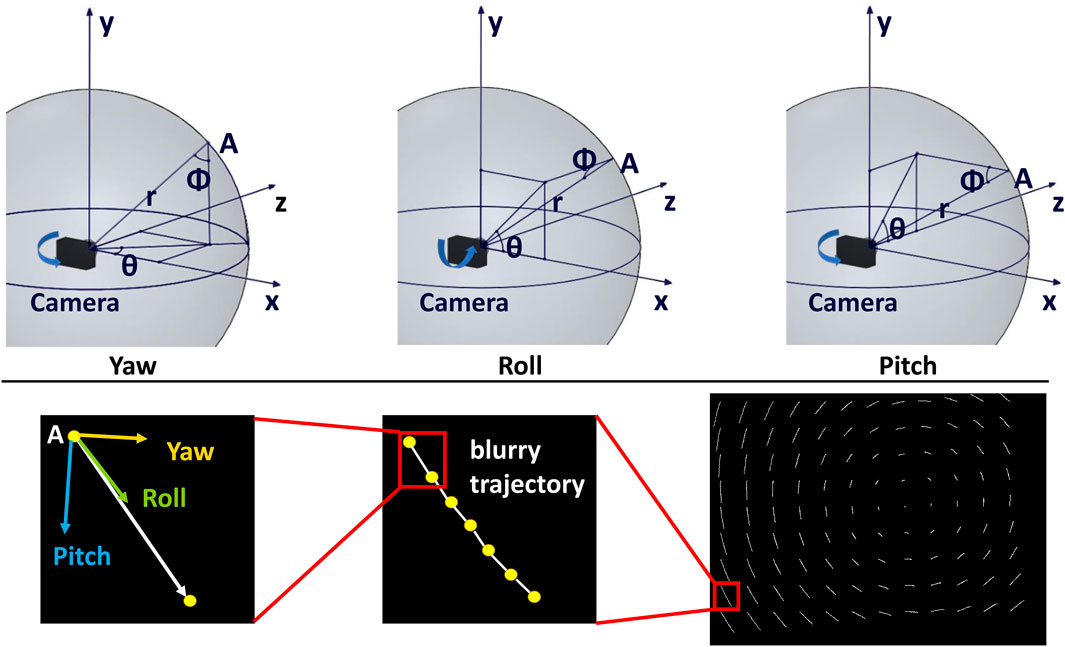
Figure 3. Blurry degree estimation based on IMU. Top:
where (fx, fy) is the camera's focal length.
As shown in Figure 3(Bottom), let
where n is the number of line segments that make up the blur trajectory and we introduce a threshold λ of L based on the image's resolution. In Section 4, we set
3.2 Blurry recovery
We select some keyframes (“Repairable” frames) from the blurry frames and use SRNDeblurNet (Tao et al., 2018) to repair these frames. These repaired clear keyframes can be used to generate other intermediate frames. The generation process is shown in Figure 4. First, we perform a perspective transformation on these “Repairable” frames so that two adjacent keyframes can have the same perspective to facilitate image stitching. Then, the stitched images are cropped to generate clear intermediate frames, and the blurry frames originally at these positions in the video are deleted as “Removable” frames.
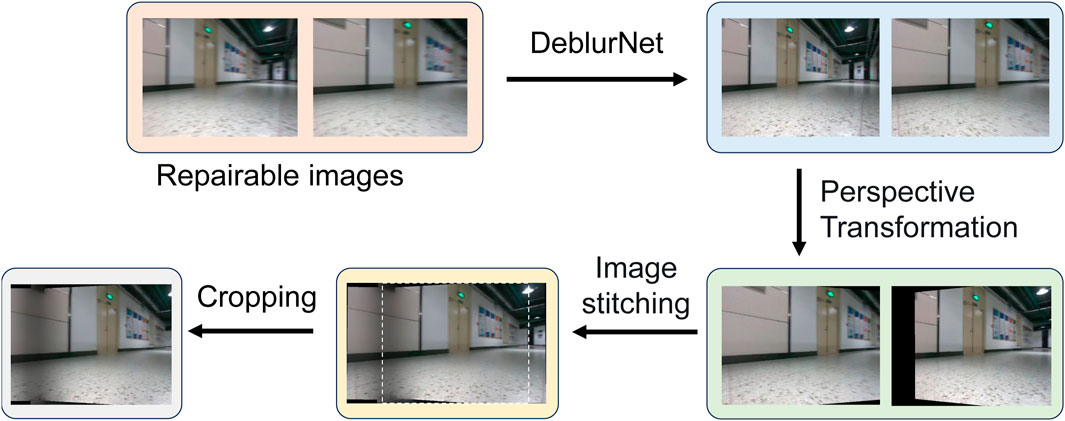
Figure 4. Image restoration process. The deblurring network processes the “Repairable” image to generate a clear image, performs perspective transformation, and finally stitches the transformed image and crops the sharp image from it.
Here, we detail the restoration and stitching process on “Repairable” frames. SRNDeblurNet (Tao et al., 2018) is constructued by Encoder-decoder ResBlock Network. After deblurring with SRNDeblurNet, we utilize IMU data to determine the position of identical pixels across different frames in the image stitching process. Subsequently, we iteratively calculate the homography matrix to perform a perspective transformation on adjacent frames. To ensure that the restored frames are continuous with the context, we predict the pixel position of the center point corresponding to the frame and use these pixels to determine the cropping position. The perspective-transformed images are then spliced and cropped.
This approach offers two advantages over traditional methods, which rely solely on feature point matching to calculate homography matrices: (1) By basing the process on IMU data, our approach substantially reduces errors caused by inaccuracies in feature point matching during image splicing. (2) Utilizing IMU data also allows us to infer the position of feature points at any given moment between two frames. This capability enables the generation of intermediate frames, resulting in a continuous and accurate frame sequence, something traditional methods cannot achieve.
4 Experiment
In this part, we first introduce the datasets in our experiments and then evaluate our motion blur detection approach. The effectiveness of our motion blur restoration method is assessed with mainstream VIO and VO methods. Limitations of our approach are finally discussed.
4.1 Datasets
Existing datasets are mainly collected for evaluating VO methods, and a dedicated dataset for motion blur scenarios is lacking. While datasets like EuRoC (Burri et al., 2016) contain partially blurred sequences, the variety and annotation of blur types are insufficient for comprehensive testing. Thus, we present BlurVO, a dataset featuring 12 motion blur sequences with four distinct types (jitter, pitch, roll, and yaw) at varying levels. The extrinsic parameters between the IMU and the camera were calibrated using the Kalibr tool (Furgale et al., 2013). The positions of all the installed equipment are shown in the Figure 5. A stereo camera and a fisheye camera are used. We use lidar to scan the surrounding environment to obtain infrared images, and a consumer-grade IMU is also installed. We use a laser scanner to track the robot.
To obtain the ground truth of the trajectory, we placed some small wooden bars as obstacles in the room for data collection. As shown in the Figure 6, we manipulated the robot through these obstacles to generate a dataset containing different motion blurs. It should be noted that it is difficult for a wheeled robot to simulate a scene with only jitter blur (i.e., the camera only moves without rotation), so we did not deliberately collect jitter blur scenes. We generate different scene sequences by permuting and combining various types of blur. The comparison between BlurVO and EUROC (Burri et al., 2016) datasets is shown in Table 2.
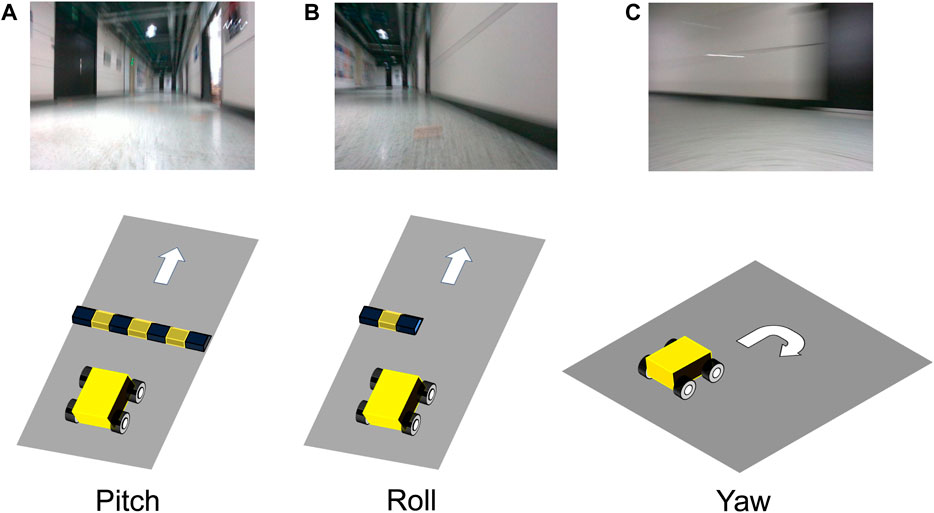
Figure 6. (A) When both robot wheels pass an obstacle simultaneously, pitch blur will occur. (B) A roll blur will occur when only one robot wheel passes an obstacle. (C) When the robot turns quickly, a yaw blur will occur.
4.2 Metrics
We benchmarked our method against ORB-SLAM3 and DSO. For evaluation, we used absolute trajectory error (ATE) and frame loss percentage (FD) to measure accuracy and robustness. It takes 1 s for the SRN network to process a
4.3 Blur detection comparison
Since it is difficult to find a suitable indicator to judge the blurriness of an image, in this paper, we define the frames that make SLAM tracking fail as blurry images and manually annotate the blurry photos in three sequences. Using these annotations, we tested the recall and accuracy of different blur detection methods. The results are shown in Table 3. Our method can identify blurry frames in the video well and perform targeted repairs. We compared the IMU-based detection method with the image-based method on the BlurVO dataset. As shown in Table 4, our method achieved an accuracy of more than 90% and a recall of 85% in detecting blurry images, which is superior to the image-based method in terms of efficiency and effectiveness.
4.4 Overall performance
Our approach significantly improves all metrics on the BlurVO dataset, especially in ATE and FD reduction. In challenging blur scenes, our method consistently outperforms ORB-SLAM3 (Campos et al., 2021) and DSO (Engel et al., 2017), demonstrating its effectiveness in handling motion blur. The detailed FD results of different methods under different BlurVO scenarios (Roll, Pitch, Yaw) are shown in Table 4. On the BlurVO data set, the initialization success rate of ORB-SLAM3 (Campos et al., 2021) and DSO (Campos et al., 2021) is meager, causing them to fail to initialize successfully. Although ORB-SLAM3 Monocular Inertial (Campos et al., 2021) combines IMU data to improve accuracy, it still does not reduce its dependence on images, so they do not improve the robustness much. Unlike this, our method makes good use of IMU data to restore blurred images and successfully enhances the robustness of VO. Excellent results are achieved in Pitch and Yaw, the two most common types of motion blur. An overall comparison of these methods on BlurVO and EuRoC (Burri et al., 2016) is shown in Table 5, 6. In BlurVO, DSO (Campos et al., 2021) has the worst robustness, so we cannot effectively measure the accuracy of DSO (Campos et al., 2021) on BlurVO through experiments, and the accuracy of ORB-SLAM3 (Campos et al., 2021) is also interfered with by blurred images. Our method effectively eliminates these interferences, thereby improving the accuracy. On the EuRoC (Burri et al., 2016) dataset, since there is not much motion blur, the improvement of our method is not apparent. ORB-SLAM3 monocular inertial (Campos et al., 2021) has high requirements for the quality of IMU data and images, which may lead to tracking failure at some nodes.

Table 6. Results of different methods on EuRoC (Burri et al., 2016) dataset.
5 Conclusion
This paper presents a novel and practical approach to enhance VO in motion blur scenarios. Our method uniquely leverages an inertial neural network to analyze IMU data, enabling the detection of various types of motion blur with high precision. This approach facilitates the intelligent recovery of blurred sequences, thereby significantly improving the robustness and reliability of VO. Furthermore, we introduce BlurVO, a comprehensive motion blur dataset designed for VO research. Future research focuses on optimizing the inertial neural network and exploring the integration of our method with VO and VIO systems, expanding the scope and applicability of robust VO solutions.
Data availability statement
The raw data supporting the conclusions of this article will be made available by the authors, without undue reservation.
Author contributions
SL: Conceptualization, Data curation, Formal Analysis, Funding acquisition, Investigation, Methodology, Project administration, Resources, Software, Supervision, Validation, Visualization, Writing–original draft, Writing–review and editing. CY: Conceptualization, Data curation, Formal Analysis, Funding acquisition, Investigation, Methodology, Project administration, Resources, Software, Supervision, Validation, Visualization, Writing–original draft, Writing–review and editing. XQ: Writing–original draft, Writing–review and editing. DC: Writing–original draft, Writing–review and editing. WS: Writing–original draft, Writing–review and editing.
Funding
The author(s) declare that no financial support was received for the research, authorship, and/or publication of this article.
Conflict of interest
Author WS was employed by Horizon Robotics.
The remaining authors declare that the research was conducted in the absence of any commercial or financial relationships that could be construed as a potential conflict of interest.
Publisher’s note
All claims expressed in this article are solely those of the authors and do not necessarily represent those of their affiliated organizations, or those of the publisher, the editors and the reviewers. Any product that may be evaluated in this article, or claim that may be made by its manufacturer, is not guaranteed or endorsed by the publisher.
References
Benseddik, H.-E., Morbidi, F., and Caron, G. (2020). Panoramis: an ultra-wide field of view image dataset for vision-based robot-motion estimation. Int. J. Robotics Res. 39 (9), 1037–1051. doi:10.1177/0278364920915248
Burri, M., Nikolic, J., Gohl, P., Schneider, T., Rehder, J., Omari, S., et al. (2016). The euroc micro aerial vehicle datasets. Int. J. Robotics Res. 35 (10), 1157–1163. doi:10.1177/0278364915620033
Campos, C., Elvira, R., Rodríguez, J. J. G., Montiel, J. M., and Tardós, J. D. (2021). Orb-slam3: an accurate open-source library for visual, visual–inertial, and multimap slam. IEEE Trans. Robotics 37 (6), 1874–1890. doi:10.1109/tro.2021.3075644
Carlevaris-Bianco, N., Ushani, A. K., and Eustice, R. M. (2016). University of Michigan north campus long-term vision and lidar dataset. Int. J. Robotics Res. 35 (9), 1023–1035. doi:10.1177/0278364915614638
Chen, L., Han, M., and Wan, H. (2013). “The fast iris image clarity evaluation based on brenner,” in International Symposium on instrumentation and measurement, sensor network and automation (IMSNA) (IEEE), 300–302.
Cho, S.-J., Ji, S.-W., Hong, J.-P., Jung, S.-W., and Ko, S.-J. (2021). “Rethinking coarse-to-fine approach in single image deblurring,” in IEEE International Conference on Computer Vision, 4641–4650.
Davison, A. J. (2003). “Real-time simultaneous localisation and mapping with a single camera,” in IEEE International Conference on Computer Vision (IEEE Computer Society), 1403. doi:10.1109/iccv.2003.12386543
Delmerico, J., Cieslewski, T., Rebecq, H., Faessler, M., and Scaramuzza, D. (2019). “Are we ready for autonomous drone racing? the uzh-fpv drone racing dataset,” in IEEE International Conference on Robotics and Automation (IEEE), 6713–6719.
Engel, J., Koltun, V., and Cremers, D. (2017). Direct sparse odometry. IEEE Trans. Pattern Analysis Mach. Intell. 40 (3), 611–625. doi:10.1109/tpami.2017.2658577
Engel, J., Schöps, T., and Cremers, D. (2014). “Lsd-slam: large-scale direct monocular slam,” in European Conference on Computer Vision (Springer), 834–849.
Furgale, P., Rehder, J., and Siegwart, R. (2013). “Unified temporal and spatial calibration for multi-sensor systems,” in IEEE International Conference on Intelligent Robots and Systems (IEEE), 1280–1286.
Geiger, A., Lenz, P., Stiller, C., and Urtasun, R. (2013). Vision meets robotics: the kitti dataset. Int. J. Robotics Res. 32 (11), 1231–1237. doi:10.1177/0278364913491297
He, M., Zhu, C., Huang, Q., Ren, B., and Liu, J. (2020). A review of monocular visual odometry. Vis. Comput. 36 (5), 1053–1065. doi:10.1007/s00371-019-01714-6
Kim, B., Son, H., Park, S.-J., Cho, S., and Lee, S. (2018). Defocus and motion blur detection with deep contextual features. Comput. Graph. Forum 37 (7), 277–288. doi:10.1111/cgf.13567
Kupyn, O., Martyniuk, T., Wu, J., and Wang, Z. (2019). “Deblurgan-v2: deblurring (orders-of-magnitude) faster and better,” in IEEE International Conference on Computer Vision, 8878–8887.
Leung, K. Y., Halpern, Y., Barfoot, T. D., and Liu, H. H. (2011). The utias multi-robot cooperative localization and mapping dataset. Int. J. Robotics Res. 30 (8), 969–974. doi:10.1177/0278364911398404
Leutenegger, S., Furgale, P. T., Rabaud, V., Chli, M., Konolige, K., and Siegwart, R. Y. (2013). “Keyframe-based visual-inertial slam using nonlinear optimization,” in Robotics: science and systems.
Ligocki, A., Jelinek, A., and Zalud, L. (2020). “Brno urban dataset-the new data for self-driving agents and mapping tasks,” in 2020 IEEE International Conference on Robotics and Automation (ICRA) (IEEE), 3284–3290.
Nistér, D., Naroditsky, O., and Bergen, J. (2004). “Visual odometry,” in IEEE Computer Society Conference on Computer Vision and Pattern Recognition. doi:10.1109/cvpr.2004.1315094
Purohit, K., Shah, A. B., and Rajagopalan, A. (2018). “Learning based single image blur detection and segmentation,” in 2018 25th IEEE International Conference on Image Processing (ICIP) (IEEE), 2202–2206.
Qin, T., Li, P., and Shen, S. (2018). Vins-mono: a robust and versatile monocular visual-inertial state estimator. IEEE Trans. Robotics 34 (4), 1004–1020. doi:10.1109/tro.2018.2853729
Roberts, R., Nguyen, H., Krishnamurthi, N., and Balch, T. (2008). “Memory-based learning for visual odometry,” in IEEE International Conference on Robotics and Automation (IEEE), 47–52.
Schubert, D., Goll, T., Demmel, N., Usenko, V., Stückler, J., and Cremers, D. (2018). “The tum vi benchmark for evaluating visual-inertial odometry,” in IEEE International Conference on Intelligent Robots and Systems (IEEE), 1680–1687.
Shi, X., Li, D., Zhao, P., Tian, Q., Tian, Y., Long, Q., et al. (2020). “Are we ready for service robots? the openloris-scene datasets for lifelong slam,” in IEEE International Conference on Robotics and Automation (IEEE), 3139–3145.
Sturm, J., Engelhard, N., Endres, F., Burgard, W., and Cremers, D. (2012). “A benchmark for the evaluation of rgb-d slam systems,” in IEEE International Conference on Intelligent Robots and Systems (IEEE), 573–580.
Tang, C., Hou, C., Hou, Y., Wang, P., and Li, W. (2017). An effective edge-preserving smoothing method for image manipulation. Digit. Signal Process. 63, 10–24. doi:10.1016/j.dsp.2016.10.009
Tao, X., Gao, H., Shen, X., Wang, J., and Jia, J. (2018). “Scale-recurrent network for deep image deblurring,” in IEEE International Conference on Computer Vision, 8174–8182.
Vankawala, F., Ganatra, A., and Patel, A. (2015). A survey on different image deblurring techniques. Int. J. Comput. Appl. 116 (13), 15–18. doi:10.5120/20396-2697
Von Stumberg, L., Usenko, V., and Cremers, D. (2018). “Direct sparse visual-inertial odometry using dynamic marginalization,” in IEEE International Conference on Robotics and Automation (IEEE), 2510–2517.
Wen, W., Zhou, Y., Zhang, G., Fahandezh-Saadi, S., Bai, X., Zhan, W., et al. (2020). “Urbanloco: a full sensor suite dataset for mapping and localization in urban scenes,” in 2020 IEEE international conference on robotics and automation (ICRA) (IEEE), 2310–2316.
Yi, X., and Eramian, M. (2016). Lbp-based segmentation of defocus blur. IEEE Trans. image Process. 25 (4), 1626–1638. doi:10.1109/tip.2016.2528042
Yin, J., Li, A., Li, T., Yu, W., and Zou, D. (2021). M2dgr: a multi-sensor and multi-scenario slam dataset for ground robots. IEEE Robotics Automation Lett. 7 (2), 2266–2273. doi:10.1109/lra.2021.3138527
Keywords: SLAM (simultaneous localization and mapping), deblur, multimodal fusion, motion blur, IMU
Citation: Luan S, Yang C, Qin X, Chen D and Sui W (2024) Towards robust visual odometry by motion blur recovery. Front. Sig. Proc. 4:1417363. doi: 10.3389/frsip.2024.1417363
Received: 14 April 2024; Accepted: 26 July 2024;
Published: 09 October 2024.
Edited by:
Raouf Hamzaoui, De Montfort University, United KingdomReviewed by:
Serhan Cosar, The Open University, United KingdomGaochang Wu, Northeastern University, China
Copyright © 2024 Luan, Yang, Qin, Chen and Sui. This is an open-access article distributed under the terms of the Creative Commons Attribution License (CC BY). The use, distribution or reproduction in other forums is permitted, provided the original author(s) and the copyright owner(s) are credited and that the original publication in this journal is cited, in accordance with accepted academic practice. No use, distribution or reproduction is permitted which does not comply with these terms.
*Correspondence: Cong Yang, Y29uZy55YW5nQHN1ZGEuZWR1LmNu
 Simin Luan
Simin Luan Cong Yang
Cong Yang Xue Qin2
Xue Qin2
